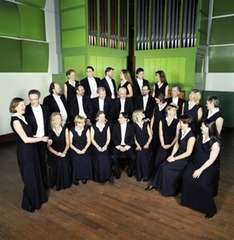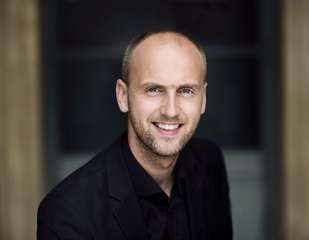|
Back
A Wee Bit of Heaven New York
St. Mary the Virgin Church, 145 West 46th Street
11/14/2017 -
Maija Einfelde: Lux aeterna
Sven David Sandström: En ny himmel och en ny jord
Anders Hillborg: Mouyayoum
Alfred Schnittke: Concerto for Choir
Swedish Radio Choir, Peter Dijkstra (Conductor)

Swedish Radio Choir (© Swedish Radio Choir)
“When I listen to hymns and canticles, I am moved more by the music than the words. I confess to being guilty of a great sin.”
St. Augustine (354-430 A.D.), Confessions
When the 32 voices of the Swedish Radio Choir finished Anders Hillborg’s Mouyayoum last night, I turned to a friend and whispered, “It must be a trick. Nobody can sing this way.”
And yes, the Mouyayoum, with its wordless diphthongs, its tonal clusters, its whispers and crescendos and almost unheard softness, was like being immersed in another universe. One thought of Ligeti’s choral music, but Hillborg’s was even more complex. Yet the result was not that 32 individual singers as a perfect machine, weaving out perfect notes in a gorgeous tapestry all its own.
Granted, this could sound awful to those who weren’t in St. Mary the Virgin Church. “Perfection”, said a philosopher, “is apt to be boring, since we are all problem-solvers.” Well, the Swedish Radio Chorus was indeed perfection. But, having solved their own musical problems, they left us to savor the results.
The setting for this a capella choir was must judicious. Not only were they in a church the size of a cathedral, but the lighting in the background was a turquoise late dusk. The chorus itself was lit by a golden light. The combination was enticing.

P. Dijkstra (© Courtesy of the Artist)
Their Dutch conductor Peter Dijkstra was the consummate leader for such consummate musicians. In Alfred Schnittke’s Choral Concerto, which had 16 different parts, he easily, gracefully did more than cue them in. (This group didn’t need cueing!) His own hand-counterpoint offered volumes and vibrato, balance and color together.
Yet from the first work, Maija Einfelde’s Lux aeterna, one had the feeling that the precision had muted personality, that these 32 singers had surrendered their own voices to be part a musical automaton.
Such thoughts were quickly diffused by the intensity of the work itself. The composition of Ms. Einfelde–the daughter of a Latvian organist and organ-builder–replaced organ color for purely vocal timbres. Starting with a soft concord, building into a great dissonant crescendo and concluding with the softness for ”lux perpetua luceat eis.”
The following work, En ny jimmel och en ny jord (“A new heaven and a new earth”) by Sven David Sandström had that same combination of 18th Century hymnal melodies with the most severe dissonance, chanting, a fierce middle section and an end of whispers. In a way, I wanted somebody to be out of tune, to have Mr. Dijkstra give a digital admonition to the sinner. Nobody, though, was anything but perfect. The balance was ideal.
It was a vocal Volvo, a piece of perfect Swedish engineering. These first two works were about seven minutes long, yet they each had so many parts, so many vocal divisions, that one was mesmerized for what seemed a far longer duration.
Anders Hillborg is one of Sweden’s international stars. Renée Fleming herself has recorded some of his songs, and his Mouyayoum is as fluid as the (meaningless, I think) title. Call it a 9-minute series of diphthongs, or pictorially, Jackson Pollack colors spreading gradually over a canvas. Sustained notes at the beginning, other vowels, other notes filling in the spaces, pulsing, vibrating, with sounds that could be ululations but actually are breathing exercises.
It could be an example of Minimalism (finished in 1985), yet this work of nuances and colors and discoloration was always fascinating.
Taking up more than half of the evening was Alfred Schnittke’s Concerto for Choir, written the same year as Mr. Hillborg’s work. For all my love for Schnittke’s music, I had never realized that the composer had converted from his secular Judaism to Roman Catholicism at this time. The music, though, bears the hallmarks of the Russian Orthodox Church and one thinks inevitably of Rachmaninoff’s hour-long Vespers. The words, though, come from the musings of a Tenth Century Armenian monk.
This 40-minute pierce bears few of Schnittke’s hallmarks: his dancing, his quotations, his sudden reversions to different styles, different ages. Yet he does, in the four sections, gradually go to ancient Russian harmonies to 20th Century dissonances and back again. The mark of a most disciplined meticulous and serious composer.
Again, one felt that the Swedish Radio Choir was not so much one chorus as a single voice which somehow divided into 32. And while my thoughts sometimes, in the third section of the work meandered onto the words in the program, the entire work became, at its finish, a kind of religious vision.
A purist would eschew encores but the congregation...er, the audience longed for more. These encores sounded like folk-songs, but were composed by two of Sweden’s finest early 20th Century composers. Wilhelm Stenhammar and Hugo Alfvén. They were, yes, quite beautiful, yet after the other music, one felt as if falling from St. Augustine’s forgiving heaven to an always welcoming planet earth.
Harry Rplnick
|